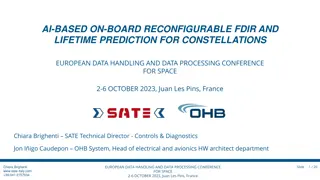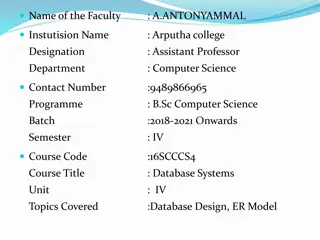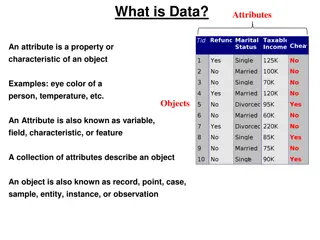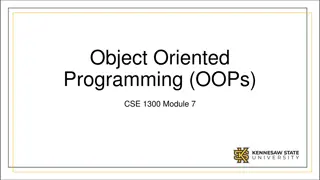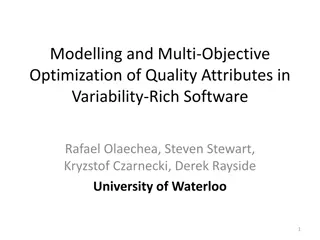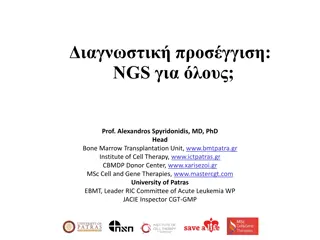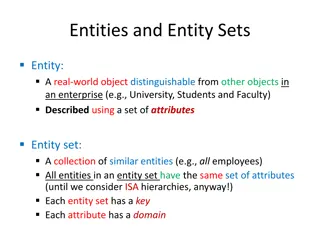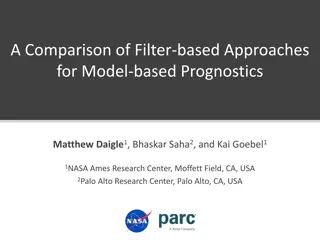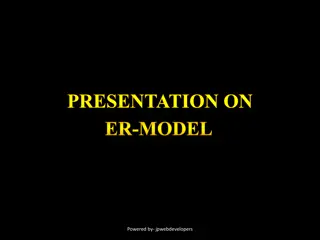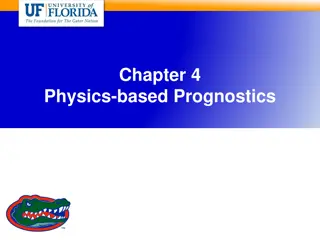
Attributes of Prognostics Methods: A Comprehensive Study
Explore the attributes of 5 prognostics algorithms for effective decision-making. Understand the advantages and disadvantages of different algorithm types such as total form and rate form. Delve into error models, physics-based methods, and data-driven approaches for optimal prognostics solutions.
Download Presentation

Please find below an Image/Link to download the presentation.
The content on the website is provided AS IS for your information and personal use only. It may not be sold, licensed, or shared on other websites without obtaining consent from the author. If you encounter any issues during the download, it is possible that the publisher has removed the file from their server.
You are allowed to download the files provided on this website for personal or commercial use, subject to the condition that they are used lawfully. All files are the property of their respective owners.
The content on the website is provided AS IS for your information and personal use only. It may not be sold, licensed, or shared on other websites without obtaining consent from the author.
E N D
Presentation Transcript
Chapter 6 Attributes of Prognostics Methods
Chapter Goal Study on attributes of 5 prognostics algorithms To provide guidelines so that the readers can choose an appropriate algorithm for their field of application We will use simple and complex crack growth problems advantages and disadvantages are discussed based on the logic of each algorithm different prognostics algorithms have different characteristics Total form: use an explicit form of degradation as a function of model parameters, loading/usage condition and time/cycle Rate form: use a differential equation form of degradation model, where degradation level can be obtained by integrating the differential equation 3 Structural & Multidisciplinary Optimization Group
Model-Form Error Models are developed under assumptions and simplifications Paris model: an infinite flat panel under mode I fatigue loading condition Many model parameters are not intrinsic they depend on boundary conditions and loading conditions Parameters from lab tests may be different from that of field conditions it is important how physics-based prognostics algorithms can correct or compensate for the model-form error 4 Structural & Multidisciplinary Optimization Group
Physics-based Methods important to understand how different algorithms identify parameters especially uncertainty in model parameters and correlation between them Some algorithms represent this uncertainty in the form of samples Some assume Gaussian distribution with estimated variance the prior knowledge on model parameters plays an important role in the performance of prognostics algorithm Bayesian-based algorithms have a systematic way of considering the prior knowledge regression-based algorithms do not have a feasible way of considering it 5 Structural & Multidisciplinary Optimization Group
Data-driven Methods Looks more attractive as they don t need physical model Especially for complex systems But data-driven approaches also employ a mathematical model to represent the degradation behavior the mathematical model does not have any physical meaning is the mathematical model good enough to represent the behavior of degradation? Complex model can represent complex degradation behavior Complex model has many parameters, which need to be identified with data Difficult to fit, over-fitting, under-fitting problems Normally (# of training data) > (2 ~ 3)*(# of unknown coefficients) data-driven approaches move the decision of selecting model form to users 6 Structural & Multidisciplinary Optimization Group
Paris Model for Fatigue Crack Growth the rate of crack growth under constant amplitude cyclic mode I loading of an infinite plate Ex) a fatigue crack growth in fuselage panel of airplanes due to repeated pressurizations ?: half crack size ? and ?: model parameters ?: number of loading cycles ? = ? ??: range of stress intensity factor ?? ??= ? ? ??? Incremental form: 8 Structural & Multidisciplinary Optimization Group
Paris Model for Fatigue Crack Growth cont. Material parameters ?: slope in log-log graph of crack growth rate and stress intensity factor ?: y-intercept at ? = 1 These parameters are extrinsic properties: unit-dependent and loading- dependent Total form Rate form (differential equation) needs to be integrated with initial crack size ?0(also need to be included as a model parameter) 2 1 ? ?(?) = ?? 1 ? 2 ? 2 ? ??+ ?0 2 the first term in the bracket is negative, while the second term is positive Large ? can make the term negative the crack will grow faster as ? increases crack goes infinity and becomes complex ?(?) 9 Structural & Multidisciplinary Optimization Group
Paris Model for Fatigue Crack Growth cont. Critical crack size Crack grows and becomes unstable When the stress intensity factor reaches the fracture toughness ??? Critical crack size for mode 1 loading 2 ??? ? ? Maintenance is required before ?? ??= Model parameter identification using measured crack size data at different loading cycles test results show some level of variability (noise) identified model parameters may show a statistical distribution Model-form error: the effect of finite plate size and the curvature of the plate is ignored 10 Structural & Multidisciplinary Optimization Group
Huangs Model for Fatigue Crack Growth Paris model: constant amplitude loading Huang s model: variable amplitude loading equivalent stress intensity factor and a modified Wheeler model depends on the stress ratio and the plastic zone size ahead of the crack tip can describe the phenomena of retardation and arrest due to overload, and the acceleration due to a state of underload following an overload ?? ??= ? ??? ?? : threshold of stress intensity factor range ? ?? ? When ???< ?? , ?? ??= 0 (no crack shrink) 11 Structural & Multidisciplinary Optimization Group
Huangs Model for Fatigue Crack Growth cont. ??? includes crack tip plasticity and crack closure after overloading ???= ???? ?, ? = ? ? ?? ?: geometric factor ??:scaling factor for the loading ratio ??: correction factor for the loading sequence interaction ???? ????: Load ratio ? = ?,?1: shaping exponents ??: plastic zone size ? : increment of the plastic zone size ?: shaping exponent ?: plastic zone size factor ????: maximum stress intensity factor ??: tensile yield strength Subscript OL: overload 12 Structural & Multidisciplinary Optimization Group
Huangs Model for Fatigue Crack Growth cont. No total form model forward Euler integration method to calculate the crack size at a given cycle Accuracy depends on integration time interval Matlab code [Huang] assumed that the plate has a 4mm-thickness and 150mm-width a geometry factor for finite plate is employed (lines 30-31) The shaping exponent ?1 is not considered since 0 ? < 0.5 uncertainties in loading, thickness and width of plate are ignored Model parameters: ?,?, ?? ,?,?,?? 13 Structural & Multidisciplinary Optimization Group
Matlab Code Huang %=== PROBLEM DEFINITION (Loading and Model Parameters) ====== dN=1; % transition cycle interval dtMeasu=1000; % measurement cycle interval dSmin=5; % min. load sNomin=65; % nominal load sOverl=[125 100 100 125 125]; % overload cNomin=[5 5 5 5 45]; % num. of cycle in a block: nominal load cOverl=[45 45 95 95 5]; % num. of cycle in a block: overload cBlock=[5000 10000 15000 20000 25000];% cycles for each block a0=0.01; % true model param including initi crack, a0 m=3.1; C=log(5.5e-11); dKth=5.2; beta=0.2; n=2.8; sY=580; thick=4e-3; width=150e-3/2; % geometry dimension %============================================================ cycle=[0:dtMeasu:cBlock(end)]'; % % % LOAD RATIO, R nb=length(cBlock); cInter(1)=cBlock(1); if nb>1; for i=2:nb; cInter(i)=cBlock(i)-cBlock(i-1); end;end 14 Structural & Multidisciplinary Optimization Group
Matlab Code Huang cont. dSmax=[]; for i=1:nb; B=[sNomin*ones(cNomin(i),1); sOverl(i)*ones(cOverl(i),1)]; dSmax(length(dSmax)+1:cBlock(i),1)= ... repmat(B,cInter(i)/(cNomin(i)+cOverl(i)),1); end; dSmax=dSmax(1:dN:end); R=dSmin./dSmax; % % % HUANG's MODEL aCurre(1)=a0; akOL(1)=a0; rOL(1)=0; for k=1:max(cycle)/dN; ak=aCurre(k); Y=(1-ak./(2*width)+0.326.*(ak./width).^2)...%geometry factor ./sqrt(1-ak./width); loca=ak./width>1; Y(loca)=0; Kmax=Y.*dSmax(k).*sqrt(pi*ak); %SIF from Eq. 6.5 Kmin=Y.*dSmin.*sqrt(pi*ak); % Scaling factor, Mr (Eq. 6.6) Mr=(1-R(k)).^(-beta); 15 Structural & Multidisciplinary Optimization Group
Matlab Code Huang cont. % Correction factor, Mp (Eqs. 6.7 and 6.8) alpha=0.35-0.29./(1+(1.08.*Kmax.^2./(thick.*sY.^2)).^2.15); ry=alpha.*(Kmax./sY).^2; if R(k)~=dSmin/sNomin; loca=ry>rOL; rOL(loca)=ry(loca); akOL(loca)=ak(loca); end Mp=(ry./(akOL+rOL-ak)).^n; loca=ak+ry>=akOL+rOL; Mp(loca)=1; % Calculate crack size dKeq=Mr.*Mp.*(Kmax-Kmin); % Eq. 6.5 rate=exp(C).*(dKeq.^m - dKth.^m); % Eq. 6.4 loca=dKeq<=dKth; rate(loca)=0; aCurre(k+1)=aCurre(k)+rate.*dN; end; crackHuang=aCurre(1:dtMeasu/dN:max(cycle)/dN+1); % % % DATA PLOT plot(cycle,crackHuang); 16 Structural & Multidisciplinary Optimization Group
Health Monitoring Data and Loading Conditions Synthetic data 1. The true values of model parameters and loading conditions are assumed 2. With true parameters and loading conditions, the physical model at different times is used to generate true degradation data 3. Random noise and deterministic bias are added to the true degradation data Synthetic data make it possible to compare the identified parameters with the true parameters possible to evaluate the accuracy of prediction remaining useful life possible to control the level of noise and bias such that their effect can be studied True parameters Paris model parameters: ? = 3.8,? = 1.5 10 10 Huang s mode parameters: ? = 3.1,? = 5.5 10 11, ?? = 5.2,? = 0.2,? = 2.8,??= 580 17 Structural & Multidisciplinary Optimization Group
Health Monitoring Data and Loading Conditions Data for Paris model 10 sets of true data by gradually increasing stress from 65 MPa to 83 MPa Each set has 26 data until 2500 cycles (every 100 cycles) Critical crack size ??= 0.05? 18 Structural & Multidisciplinary Optimization Group
Health Monitoring Data and Loading Conditions Data for Huang s model 10 data sets with crack retardation and acceleration due to complex loadings a loading block: fixed 5 MPa minimum load, two maximum loads (nominal load and overload) Table shows 5 loading blocks scenario (5,000 cycles for each block) 19 Structural & Multidisciplinary Optimization Group
Health Monitoring Data and Loading Conditions Data for Huang s model cont. 10 cases differ by the gradually increasing max loads by 1 MPa Ex) case 1: nominal load 65 MPa & overload 125 MPa lasting 5 & 45 cycles Retardation: the crack does not grow at all between 5000 and 15000 cycles After 15000 cycles, the crack grows fast because underloads followed by overloads The crack grows slowly after 20000 cycles because the number of cycles for overloads is reduced 20 Structural & Multidisciplinary Optimization Group
Health Monitoring Data and Loading Conditions Noise and bias Deterministic bias: 3mm Uniformly distributed random noise: ?[ ?,?]mm, ? = 0,1,5mm Data-driven approaches: Set 6 is prediction set for Paris model (all others are training set) Set 8 is prediction set for Huang s model (all others are training set) b=-0.003; v=0.001; crackSimpleMeas=crackSimple + v*(2*rand(10,26)-1) + b; crackHuangMeas=crackHuang + v*(2*rand(10,26)-1) + b; 21 Structural & Multidisciplinary Optimization Group
Comparison of Physics-based Algorithms Comparing physics-based prognostics algorithms for accuracy in parameter and RUL focus on uncertainty and correlation in model parameters as well as model-form errors Approaches likelihood: normal distribution, prior: uniform (see table in the next slide) Use 5000 samples to represent distributions (NLS, BM, PF) NLS Identify mean and covariance t-distribution to generate 5000 samples BM 6250 samples from MCMC and 1250 burn-in samples removed PF 5000 particles from prior distribution resampled based on weights 23 Structural & Multidisciplinary Optimization Group
Prior Distributions 24 Structural & Multidisciplinary Optimization Group
Correlation in Prognostics Performance of different algorithms can be evaluated based on their ability to identify model parameters Focus on physics-based prognostics is how to identify model parameters accurately with a smaller number of measured data Correlation between parameters is the most challenging aspects Probabilistic identification of parameters (due to noise and model-form error) Marginal PDF is not accurate; Joint PDF (correlation) must be identified Without properly identifying the correlation, the predicted RUL can be significantly different from the real one Even if the accurate value of each parameter may not be identified, the RUL prediction can be reliable all combinations of the correlated parameters can yield the same prediction 25 Structural & Multidisciplinary Optimization Group
Correlation between Model Parameters Paris model parameters ? and ? are strongly correlated They can be identified with their correlation rather than individual values For a given ?, multiple ?,? can yield the same growth rate How can the change in correlation affect predictions Paris model (logarithm) ?? ?? log? + ?log ? ?? = log ?? ?? log?true+ ?truelog ? ?? = log Linear relationship b/w ? and log? log? = log?true+ ?true ? log ? ?? 26 Structural & Multidisciplinary Optimization Group
Correlation between Model Parameters cont. Correlation gradually changes as crack grows log? = log?true+ ?true ? log ? ?? there is no deterministic relationship between parameters, and the relationship evolves as the crack size increases The slope changes w.r.t. the true value the true parameters can eventually be identified since the correlation converges to the true value by intersecting many correlation lines 0.06 Data Median 90% PI Threshold True 0.05 True parameters can be obtained with only three exact degradation data Crack size (m) 0.04 0.03 0.010000000000000 0.010286799119103 0.010589640425939 0 0.02 ? = , ? = 100 200 0.01 0 ? = 3.8,log ? = 22.6204 0 1000 2000 3000 Cycles 0.1825 0.4746 0.4746 1.2339 Very small covariance 10 18 ?= 27 Structural & Multidisciplinary Optimization Group
Correlation between Model Parameters cont. When data include noise, the linear relationship cannot be obtained Measurement at 2 different cycles 2 different slopes No noise case: The intersection of two lines can identify the true model parameters Noisy data case Due to uncertainty, line thickness is proportional to the level of noise Intersection is an area, not a point uncertainty in the identified parameters Uncertainty increases when the level of noise is large and when the two slopes are not much different 28 Structural & Multidisciplinary Optimization Group
Correlation between Model Parameters cont. Sensitivity of parameter identification (small noise case) 0.0106 : rounding error at 4th significant digit ? = 0.0100 0.0103 Even if the measured data have very small errors, the identified parameters are distributed in a very wide range. because only three data are used, and the slopes of correlation lines are very close to each other (the crack does not grow much during the three cycles) Too wide 90% PI, and median failed to follow the true degradation more data are required to identify the correlation well 5 3x 10 0.06 Data Median 90% PI Threshold True Sampling True 0.05 2 Crack size (m) 0.04 ln(C) 1 0.03 0.02 0 0.01 -1 0 -10 -5 0 5 4 0 1000 2000 3000 m Cycles x 10 29 Structural & Multidisciplinary Optimization Group
Correlation b/w Parameters and Loading Black line: with correct loading Red line: with smaller loading A smaller loading leads to a larger parameter ?1 That is, ? and log? are negatively correlated prediction results from physics-based approaches can be accurate even under incorrect loadings because the model parameters are updated to the equivalent parameters to the incorrect loading ?? ?? log? + ?log ? ?? = log ? ? log? = log? + ?log ?? ?? log? + ? log ? ?? = log 30 Structural & Multidisciplinary Optimization Group
Correlation b/w Parameters and Loading cont. Use dataset 10 ( ?true= 83MPa) with a wrong load of ? = 65MPa Prognostics using NLS Overestimating log?, but degradation follows the true one -21 0.06 Sampling True Data Median 90% PI Threshold True 0.05 -21.5 Crack size (m) 0.04 ln(C) -22 0.03 0.02 -22.5 0.01 -23 0 3.7 3.75 3.8 3.85 3.9 3.95 0 1000 2000 3000 m Cycles 31 Structural & Multidisciplinary Optimization Group
Compensating for Model-Form Error Correlation b/w load & parameter can be used for compensating model- form error the actual behavior of degradation is different from the physical model due to simplifications and assumptions in the physical model The error in model-form is often transferred to an error in loading conditions Ex) Paris model with finite plate ? = ? ? Correct stress intensity factor ?: apparent stress intensity factor, ?: correction factor The error in ? will be compensated by identifying equivalent parameters 32 Structural & Multidisciplinary Optimization Group
Correction Factor The capability of compensating error in loading condition by identifying equivalent model parameters is limited to the case when the correction factor remains constant the correction factor is a function of crack size, and it will evolve as the crack grows 2.0 Center Crack, Infinite Plate Center Crack, Finite Plate Edge Crack, Finite Plate 1.8 Correction Factor, Y 1.6 1.4 1.2 1.0 0.8 0.05 0.1 0.15 0.2 a/W 33 Structural & Multidisciplinary Optimization Group
Correlation b/w Initial Crack Size and Bias Bias in data: sensor calibration error, unknown crack location, inclined crack orientation Bias in measured data can be handled in physics-based approaches but not in data-driven approaches Constant bias won t affect data-drive approaches The bias can play an important role in physics-based method Positive bias: overestimating ? = ? ?? underestimate ? In order to identify bias, it is necessary to include it as a parameter ????= ??+ ? ?? 2 1 ? ????= ??+ ? = ??? 1 ? 2 ? 2 ? ??+ ?0 ?? + ? 2 34 Structural & Multidisciplinary Optimization Group
Correlation b/w Initial Crack Size and Bias cont. the bias is correlated with the initial crack size Assume no noise in data ????= ?0+ ? ?0 ????, infinitely possible combinations of ?0 and ? linear For a given ?0 correlation Ex) ? and ? are known, ? = 3mm, use 2 exact data to find ?0 and ? NLS identified ?0= 0.01m and ? = 0.003m Without bias correction With bias correction 0.06 0.06 Data Median 90% PI Threshold True Data Median 90% PI Threshold True 0.05 0.05 Crack size (m) Crack size (m) 0.04 0.04 0.03 0.03 0.02 0.02 0.01 0.01 0 0 0 1000 2000 3000 0 1000 2000 3000 Cycles Cycles 35 Structural & Multidisciplinary Optimization Group
Prior Information Prior information: preexisting knowledge for unknown parameters expert s opinion, previous experience or knowledge from similar systems Ex) Initial crack size: estimated from traditional NDT Ex) bias: measurement error from known crack size Ex) Model parameters ? and ?: from lab tests Regression-based methods (LS, NLS) Frequentist s method, only observed information is used, no prior information Bayesian-based methods (BM, PF) Use prior (subjective) information, prior PDF Without prior, BM is equivalent to maximum likelihood estimate 36 Structural & Multidisciplinary Optimization Group
Prior information for Bayesian Inference Performance of Bayesian inference depends on the uncertainty in prior and the variability in measured data Small uncertainty in the prior: measurement data may not contribute to improving the uncertainty in the posterior distribution (the prior distribution contributes the most to the posterior distribution) Small variability in measured data: not much use for the prior (the posterior distribution is dominated by measured data) Effect of the prior distribution If the uncertainty in prior is small and it covers the true value of parameter, the prior can help accelerating the convergence of the posterior distribution If the uncertainty in prior distribution is too big, it will not help to reduce uncertainty in the posterior distribution non-informative prior: infinitely wide prior distribution, unnecessary to consider the prior distribution 37 Structural & Multidisciplinary Optimization Group
Prior information for Bayesian Inference cont. Incorrect prior Wrong or inconsistent prior with measured data, it can prevent parameters from being accurately identified or slow down the estimation process Ex) ?true= 3.8 but ?prior~?[3.0,3.5]: the posterior will not include the true parameter no matter how many measured data are used Use dataset 6 with ? = 1mm up to 1500 cycles NLS show much larger uncertainty compared to BM and PF PF NLS BM 0.06 0.06 0.06 Data Median 90% PI Threshold True Data Median 90% PI Threshold True Data Median 90% PI Threshold True 0.05 0.05 0.05 Crack size (m) Crack size (m) Crack size (m) 0.04 0.04 0.04 0.03 0.03 0.03 0.02 0.02 0.02 0.01 0.01 0.01 0 0 0 0 1000 2000 3000 0 1000 2000 3000 0 1000 2000 3000 Cycles Cycles Cycles 38 Structural & Multidisciplinary Optimization Group
Prior information for Bayesian Inference cont. Inferior performance of NLS can be explained by its inability to utilize the prior information Uniform prior cuts off the posterior distribution of BM and PF (make it narrower) -21 -10 BM PF True Prior NLS BM True Prior -21.5 -15 -22 -20 ln(C) ln(C) -22.5 -25 -23 -30 -23.5 -35 -24 -40 3 3.5 4 4.5 0 2 4 6 8 10 m m 39 Structural & Multidisciplinary Optimization Group
Prior information for Bayesian Inference cont. The influence of prior is gradually reduced as more data are used Increase # of date from 1500 to 2500 cycles NLS BM PF 0.06 0.06 0.06 Data Median 90% PI Threshold True Data Median 90% PI Threshold True Data Median 90% PI Threshold True 0.05 0.05 0.05 Crack size (m) 0.04 Crack size (m) Crack size (m) 0.04 0.04 0.03 0.03 0.03 0.02 0.02 0.02 0.01 0.01 0.01 0 0 0 0 1000 2000 3000 0 1000 2000 3000 0 1000 2000 3000 Cycles Cycles Cycles -20 -21 NLS BM True Prior BM PF True Prior -21.5 -21 -22 -22 ln(C) ln(C) -22.5 -23 -23 -24 -23.5 -25 -24 3 3.5 4 4.5 3 3.5 4 4.5 m m 40 Structural & Multidisciplinary Optimization Group
Sampling Error the prediction result from PF is worse than the other two accumulated sampling error during the updating process (particle depletion) only a few samples remain after 25 updating process for PF (blue dots) particle depletion has been the major drawback of PF Possible remedy: add random samples from an arbitrary distribution during the prediction step so that duplicated particles are not generated can change probabilistic characteristics of parameters and can increase the variance of parameters BM has sampling error due to the random walk process in MCMC sampling initial sample locations, the proposal distribution and the acceptance ratio have an effect on the sampling results marginal density function can be used for the proposal distribution 41 Structural & Multidisciplinary Optimization Group
Uncertainty Representation & Updating Process NLS Deterministic parameters (mean) and added linear correlation based on the covariance matrix (use t-distribution) efficient for a strong linear correlation between unknown parameters not easy to find accurate relation for many unknown parameters BM and PF a joint posterior distribution for unknown parameters (correlation can be well identified) Posterior distributions are not limited to standard distribution types (represented by samples) BM is faster when degradation model is given in a total form BM can be impractical when the degradation model is given in the rate form PF that is based on sequential updating process is only a practical method for the rate form of degradation model 42 Structural & Multidisciplinary Optimization Group
Results Summary NLS can be a simple and accurate prediction method when the parameters are linearly correlated good with Gaussian noise in data and mildly nonlinear model BM is an efficient method when the degradation model is given as a total form equation the degradation model has to be computationally inexpensive Grid approximation method for a small number of parameters Most practical problems use MCMC to generate samples Many MCMC samples are required for high-dimensional sampling Choosing appropriate options in MCMC is a real problem (initial parameter values and the width of proposal distribution) Too small width: not fully covering the target distribution Too large width: many duplications in samples by not accepting new samples the width of proposal distribution depends on the expected uncertainty in un- known parameters 43 Structural & Multidisciplinary Optimization Group
Results Summary cont. PF is considered easy to use (not many options) state transition function as a physical model (rate form) particle depletion problem when many measured data are available 44 Structural & Multidisciplinary Optimization Group
Comparison of Data-driven Algorithms focuses are on the selection of model form, performance under noise and the number of training data Gaussian process (GP) model Inputs: three degradation from previous time increments Global function: first-order polynomials, reflecting monotonicity of degradation Uncertainty: 5000 samples from Student s t-distribution Neural Network (NN) model Inputs: three degradation from previous time increments pure linear functions are used for both hidden and output layers (monotonicity) only one hidden node is considered Outlier: results beyond the bound of 2? 30 repetition for prediction intervals 46 Structural & Multidisciplinary Optimization Group
Simple Crack Growth Model No training dataset, prediction dataset 6 up to 1500 cycles uniformly distributed random noise ? 0.001,0.001 v=0.001; crackSimpleMeas=crackSimple(6,1:16) + v*(2*rand(1,16)-1); GP predicts slightly better than NN Higher (data/parameter) ratio for GP NN with ?? = 26 GP with 0= 0.05 0.06 0.06 Data Median 90% PI Threshold True Data Median 90% PI Threshold True 0.05 0.05 Crack size (m) Crack size (m) 0.04 0.04 0.03 0.03 0.02 0.02 0.01 0.01 0 0 0 1000 2000 3000 0 1000 2000 3000 Cycles Cycles 47 Structural & Multidisciplinary Optimization Group
Simple Crack Growth Model cont. prediction results using data up to 500 cycles with zero noise + training sets 5 and 7 (up to 2500 cycles) good prediction results in the interpolation regions GP works well in the interpolation region with small noise (accurate correlation) Beyond 2500 cycles, extrapolation and prediction deteriorates quickly NN works better for extrapolation, but accuracy is worse than GP NN with ?? = 26 GP with 0= 0.05 0.06 0.06 Data Median 90% PI Threshold True Data Median 90% PI Threshold True 0.05 0.05 Crack size (m) Crack size (m) 0.04 0.04 0.03 0.03 0.02 0.02 0.01 0.01 0 0 0 1000 2000 3000 0 1000 2000 3000 Cycles Cycles 48 Structural & Multidisciplinary Optimization Group
Simple Crack Growth Model cont. Large noise ?( 0.005,0.005) prediction performance of GP is significantly deteriorated (correlation cannot clearly be identified) GP performance is improved with = 0.001 the optimum value of the hyper-parameter remains the same as the initial value the prediction results totally depend on the linear global function GP with 0= 0.001 GP with 0= 0.05 0.06 0.06 Data Median 90% PI Threshold True Data Median 90% PI Threshold True 0.05 0.05 Crack size (m) 0.04 Crack size (m) 0.04 0.03 0.03 0.02 0.02 0.01 0.01 0 0 0 1000 2000 3000 0 1000 2000 3000 Cycles 49 Cycles Structural & Multidisciplinary Optimization Group
Simple Crack Growth Model cont. NN outperformed GP When there is a large level of noise in data, having training sets may not help much in improving prediction accuracy when the level of noise is large, it may help to use time/cycle as an input in NN in-stead of using the previous data as input time as input and sigmoid function NN with ?? = 26 0.06 0.06 Data Median 90% PI Threshold True Data Median 90% PI Threshold True 0.05 0.05 Crack size (m) 0.04 Crack size (m) 0.04 0.03 0.03 0.02 0.02 0.01 0.01 0 0 0 1000 2000 3000 0 1000 2000 3000 Cycles 50 Cycles Structural & Multidisciplinary Optimization Group

